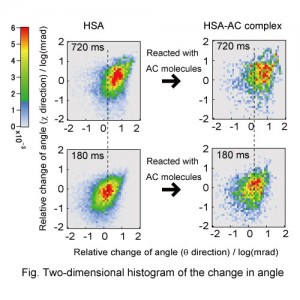Mapping intramolecular motion in single protein molecules Diffracted X-ray tracking (DXT) of tilting and twisting

The quantitative evaluation of molecular motion in protein active sites is used as a guideline for molecular design in drug discovery and similar areas, and as a result it is important to be able to measure as accurately as possible the difference in motion between normal and abnormal proteins. For this reason Professor Yuji Sasaki’s research group at the University of Tokyo Graduate School of Frontier Sciences developed diffracted X-ray tracking (DXT), using which it is possible to track with high accuracy the internal motion of a single protein molecule. However, the range of angular variation within the internal molecular structure that could be tracked with this method was extremely limited at just 2.4 degrees, and it was difficult to capture statistical data on intramolecular motion.

© Yuji C Sasaki. Split two-dimensional histogram of the angular motion of (a) Human Serum Albumin (HSA) and (b) HSA bound with 2-anthracenecarboxylic acid (AC).
In this latest research, Professor Sasaki, Assistant Professor Kouhei Ichiyanagi (Sasaki Laboratory), Research Scientist Hiroshi Sekiguchi (Japan Synchrotron Radiation Research Institute, JASRI), and Professor Yoshihisa Inoue (Division of Applied Chemistry, Graduate School of Engineering, Osaka University) succeeded in rapidly and efficiently obtaining statistical data on intramolecular tilting and twisting motions of a single protein molecule over a wide angle up to 22.6 degrees. With the improved DXT technique, complicated intramolecular tilting and twisting motions of protein molecules can be monitored over a wide angle and within a short period of time by focusing hard X-rays with a wide energy bandwidth (8-18 keV; wavelength 0.7-1.6 nm). This result was obtained by installing a toroidal X-ray mirror at the BL28B2 beamline of SPring-8, and suggests that the DXT technique can be employed at radiation facilities worldwide.
In the future, the DXT technique will open a path to the analysis of intramolecular dynamics of single proteins, enabling the early detection of the effects and side effects of new drugs and the presence of abnormal proteins, as well as the evaluation of as-yet unknown functions through the quantitative correlation analysis between the functionality and intramolecular motion properties of protein molecules.
Press release (Japanese)
Paper
Kouhe Ichiyanagi, Hiroshi Sekiguchi, Masato Hoshino, Kentaro Kajiwara, Kentaro Hoshisashi, Chang Jae-Won, Maki Tokue, Yufuku Matsushita, Masaki Nishijima, Yoshihisa Inoue, Yasunori Senba, Haruhiko Ohashi, Noboru Ohta, Naoto Yagi, Yuji C Sasaki,
“Diffracted X-ray tracking for monitoring intramolecular motion in individual protein molecules using broad band X-ray”,
Review of Scientific Instruments 84, 103701-6 (2013), doi: 10.1064/1.4819305.
Article link
Links
Graduate School of Frontier Sciences
Department of Advanced Materials Science, Graduate School of Frontier Sciences







